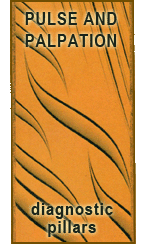The Slow Irregular, Knotted, Bound Pulse (Jie Mai)

Slow Irregular Pulse (結脈 Jie Mai, knotted, bound) Key points: slow with irregular pauses. Indications: (forceful) Stagnation, cold, tumor or masses: pathogenic factors stagnate within the vessels, block blood circulation.
 Last modified: August 2, 2009 ·
Last modified: August 2, 2009 ·  al ·
al ·  No Comments
No Comments
 Tags: Diagnosis, Practitioners · Posted in: Pulse Class, Pulse-Palpation
Tags: Diagnosis, Practitioners · Posted in: Pulse Class, Pulse-Palpation
The Deficient, Empty, Vacuous Pulse (Xu Mai)

Deficient Pulse (虛脈 Xu Mai, empty, vacuous) Key points: forceless at all three levels, can be wide.
 Last modified: August 1, 2009 ·
Last modified: August 1, 2009 ·  al ·
al ·  No Comments
No Comments
 Tags: Diagnosis, Palpation · Posted in: Pulse Class, Pulse-Palpation
Tags: Diagnosis, Palpation · Posted in: Pulse Class, Pulse-Palpation
The Excessive, Full, Replete Pulse (Shi Mai)

Excessive Pulse (實脈 Shi Mai, full, replete) Key points: long, wide, forceful on all three depths. Indications: pathogenic factors with strong anti-pathogenic qi: excess condition causes excess pulse.
 Last modified: July 31, 2009 ·
Last modified: July 31, 2009 ·  al ·
al ·  No Comments
No Comments
 Tags: Diagnosis, Palpation · Posted in: Pulse Class, Pulse-Palpation
Tags: Diagnosis, Palpation · Posted in: Pulse Class, Pulse-Palpation
The Flooding, Surging, Overflowing Pulse (Hong Mai)

Flooding Pulse (?? Hong Mai, surging, overflowing) Key points: forceful, wide, comes stronger than going Indications: qi level heat (wen bing, four levels), yang ming jing bing (Shang Han Lun), or Lung and Stomach heat (zang fu). All three of these pathologies are describing the same presentation.
 Last modified: July 30, 2009 ·
Last modified: July 30, 2009 ·  al ·
al ·  No Comments
No Comments
 Tags: Diagnosis, Palpation · Posted in: Pulse Class, Pulse-Palpation
Tags: Diagnosis, Palpation · Posted in: Pulse Class, Pulse-Palpation
The Thin Pulse (Xi Mai)

Thin Pulse (細脈 Xi Mai) key point: thin. Indications: qi deficiency is unable to command the blood hence, it doesn’t fill the vessels.
 Last modified: July 28, 2009 ·
Last modified: July 28, 2009 ·  al ·
al ·  No Comments
No Comments
 Tags: Diagnosis, Palpation · Posted in: Pulse Class, Pulse-Palpation
Tags: Diagnosis, Palpation · Posted in: Pulse Class, Pulse-Palpation
The Soggy, Weak-Floating, Soft Pulse (Ru Mai)

Soggy Pulse (濡脈 Ru Mai, weak-floating, soft) Key points: superficial, thin, forceless. Indications: damp depresses the vessels, qi and blood cannot easily flow through the vessels leading to the thin, forceless and ultimately rootless pulse.
 Last modified: July 27, 2009 ·
Last modified: July 27, 2009 ·  al ·
al ·  No Comments
No Comments
 Tags: Diagnosis, Palpation · Posted in: Pulse Class, Pulse-Palpation
Tags: Diagnosis, Palpation · Posted in: Pulse Class, Pulse-Palpation
The Faint, Minute Pulse (Wei Mai)

Faint Pulse (微脈 Wei Mai, minute) Key points: thin, forceless, vague. Indications: yin, yang, qi, or blood deficiency: four substances can’t fill vessel.
 Last modified: July 26, 2009 ·
Last modified: July 26, 2009 ·  al ·
al ·  No Comments
No Comments
 Tags: Diagnosis, Palpation · Posted in: Pulse Class, Pulse-Palpation
Tags: Diagnosis, Palpation · Posted in: Pulse Class, Pulse-Palpation
The Frail, Weak Pulse (Ruo Mai)

Frail Pulse (弱脈 Ruo Mai, weak) Key points: deep, thin, forceless. Indications: deficiency of yin, yang, qi, or blood: if deeper, more yang deficiency, if pulse lacks root, more yin deficiency.
 Last modified: July 25, 2009 ·
Last modified: July 25, 2009 ·  al ·
al ·  No Comments
No Comments
 Tags: Diagnosis, Palpation · Posted in: Pulse Class, Pulse-Palpation
Tags: Diagnosis, Palpation · Posted in: Pulse Class, Pulse-Palpation
The Scattered, Dissipated Pulse (San Mai)

Scattered Pulse (散脈 San Mai, dissipated) Key points: superficial, scattered without root, uneven rhythm. Indications: exhaustion of qi, functional failure of the zang fu organs.
 Last modified: July 24, 2009 ·
Last modified: July 24, 2009 ·  al ·
al ·  No Comments
No Comments
 Tags: Diagnosis, Palpation · Posted in: Pulse Class, Pulse-Palpation
Tags: Diagnosis, Palpation · Posted in: Pulse Class, Pulse-Palpation
The Long Pulse (Chang Mai)

Long Pulse (長脈 Chang Mai) Key point: long. Indications: normal (tall person, or young and healthy), Liver yang rising, excessive interior heat.
 Last modified: July 23, 2009 ·
Last modified: July 23, 2009 ·  al ·
al ·  No Comments
No Comments
 Tags: Diagnosis, Palpation · Posted in: Pulse Class, Pulse-Palpation
Tags: Diagnosis, Palpation · Posted in: Pulse Class, Pulse-Palpation
